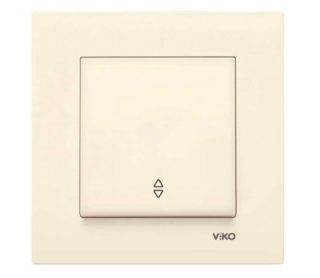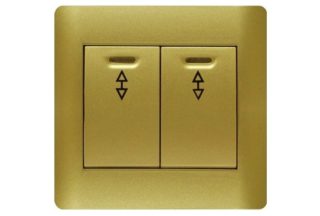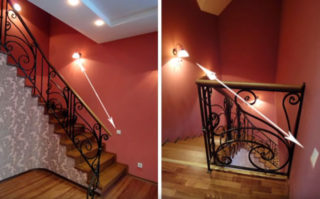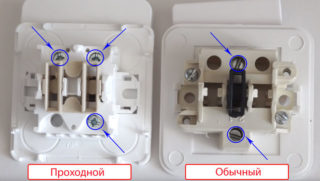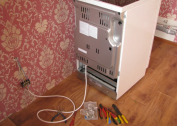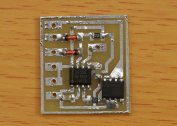Electric switches and switches are technical devices that allow you to close and open the circuit at the right time. Mechanisms perform similar functions, although they have significant differences. Novice installers and regular customers often confuse devices. In order not to make a mistake when buying, you need to familiarize yourself with the general principles, pluses, minuses and find out how the switch differs from the switch.
Key Benefits
In appearance, it is impossible to distinguish devices, but the principle of operation is different. In some rooms it is inconvenient to use the switch (for example, in long corridors). The main advantages of the switches are:
- the ability to connect several electrical networks to each other;
- the device allows you to control (enable, switch, disconnect) a branched circuit from one point;
- one light source can be activated from different places in the room (for example, turn on the chandelier in the guest room from the corridor).
In fact, the device is constantly in working condition - this is one of the main differences between the switch and the switch. Using the changeover contacts, additional electrical circuits are created in the network.
Operating principle
To understand what a switch is, you need to consider the principle of its operation and purpose. The device serves to redirect the flow of electricity to another circuit - one circuit is disconnected and the other is closed at the same time. Therefore, the minimum number of contacts for such a device is three. For mechanisms with two or more “keys”, the number doubles.
A switch is a switch between electrical conductors of reverse voltage. Appointment - management of one light source from different places. They are mainly used for rooms with a large area, for example, stadiums, production shops or warehouses.
Types of devices
There are several switch options. To choose the optimal one, one should take into account the type of problem being solved, the necessary way to control the mechanism, and the parameters of the existing electrical circuit.
On the management and movement of the toggle switch, the following types are distinguished:
- angular (with internal contacts or yokes);
- push;
- rotary.
Corner devices of both types differ in the ability of the toggle switch to be in two fixed positions. The shift of the handle allows you to move the movable contact from one circuit to another. The movement of direct and alternating currents is redirected.
For toggle switches use different connection schemes. There are no bans, the final version depends on the needs of the premises and the imagination of the electrician.
The maximum load is 6 amperes. At the same time, a small level of resistance is observed (not more than 0.02ohm). The reliability of such equipment is determined by the number of possible switches (the average number is 10,000 times).
Additional classification - by keys. There are three main types:
- with one button;
- with two;
- with three.
More keys are acceptable, but unsafe. Each has three contacts. If there are too many “jumpers”, a circuit will be inevitable, and the circuit will burn out.
According to the internal structure of the switches are:
- classic (walk-through);
- intermediate (cross);
- combined.
The difference between the passage and cross switch in the number of working electrodes.In the first case - three contacts, in the second - two at the input and output of the electric circuit. Intermediates are used to control multiple light sources, not one.
Household use
Installation or remodeling of wiring implies functionality and ease of use. Therefore, before installation, a plan is drawn up in which the total number of bulbs, switches and sockets is prescribed. Transition devices are suitable for connection in the following situations:
- multi-level buildings - switches will turn off the lights on any floor;
- long corridors - you can turn on the lamps at the beginning, and turn them off at the end;
- bedrooms - if you install one mechanism at the entrance, and the second near the bed, you will not need to get up to turn off the main light.
Use transient devices in all similar situations. Especially relevant in large offices, hotels and other similar buildings.
Re or circuit breaker
To make the final choice, you should develop an initial wiring plan or study the existing one. Usually it is attached to the technical documentation of the apartment or building. Then you need to determine the longest sections or rooms (workshops, corridors), imagine possible situations based on personal preferences (such as in a bedroom).
If you need to control one light source from different sides, you must install the switch. Then choose the type of device - switch through and cross. The first allows you to turn off the lamp from two different points, the second - from three or more. To establish the latter type and properly wire the wires, it is better to invite a professional electrician.
When connecting several switches at different points in the apartment or premises, you should save the wiring plan. Otherwise, if repair or redevelopment is required, it will be difficult to establish all the contact options for outlets and other elements.
Can I use the switch as a switch
In the process of using, different situations arise. For example, after buying an apartment, it turned out that the previous owners installed switches in several rooms, and now their operation is not necessary.
To redirect the action of the device, it is enough not to use the third contact, which transfers the flow of electricity to another channel. First of all, they determine the complete circuit of the electrical network that closes with this switch. Secondary contacts are then isolated. After that, the mechanism will cease to redirect the current and will begin to work like a normal switch.
Loop-through wiring diagrams
The connection and layout of the electrical network with switches depends on several factors: the number of controlled light sources and controls, the need to install additional (intermediate) disconnection points, and others. For example, in a multi-storey building, you should calculate the possibility of controlling the light at all levels, the scheme will be significantly different from that needed for one room.
To work with the switches in the wiring using three-wire cables. If others (with a smaller number) are installed, you will have to ditch the walls and connect a new wiring section or consider other options for controlling light sources to connect.
Connection of two loop-through switches
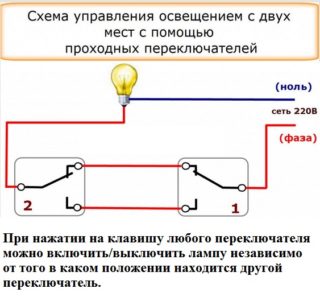 As a rule, on the latest models, on the inside there is a connection diagram, which should be followed when closing the circuit. Two loop-through devices allow you to control one light source, a maximum of several small bulbs of the same network, for example, in the corridor.
As a rule, on the latest models, on the inside there is a connection diagram, which should be followed when closing the circuit. Two loop-through devices allow you to control one light source, a maximum of several small bulbs of the same network, for example, in the corridor.
At installation it is necessary to consider the type of switch - single-key or two-key. The latter is two single-key type mechanisms in one box (used for convenience and space saving). For a six-pin switch, two three-wire wires fail.
When connecting, it is important to consider the number of contacts of the mechanism - three or six. In order for the circuits to close in the right direction, carefully connect the electrodes and the cable.
Connection of several parallel consumers
Multi-pin walk-through switches are used for multiple users working in parallel. A distinctive moment is the connection to the phases. The terminals at the input from the junction box must be connected to each other and connected to one single phase. If you connect different to the same device, there will be a short circuit and burnout of the entire electrical circuit.
Intermediate management point
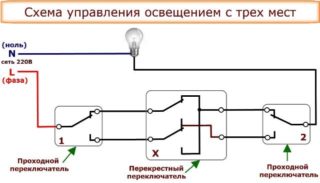 An additional control is needed to switch from several points - three or more. This is the difference between the passage switch and the cross switch - in this case, the latter are used.
An additional control is needed to switch from several points - three or more. This is the difference between the passage switch and the cross switch - in this case, the latter are used.
An intermediate mechanism changes the direction of the current in the circuit. The action depends on the position of the switch at the two ends of the wiring - which network is supplied with voltage from different sides.
The number of intermediate elements does not have to be even. Otherwise, the circuit will not switch over - the current direction will return to the initial channel.
For two switches to one light source, it is not necessary to make a complex wiring diagram. The main feature is the presence of a three-core cable. To install intermediate elements and more devices, help is needed. It is important to consider the permissible circuit voltage. If necessary, an additional wire is pulled from the shield, a separate junction box is installed.
